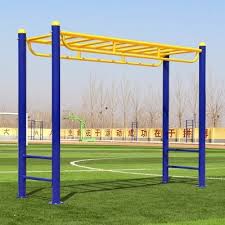Durability of Metal
Metal is one of the most durable materials used in commercial playground equipment. Typically, steel is used because of its high strength and resistance to wear and tear, which are crucial for the heavy use seen in commercial settings. Powder-coated steel is particularly effective as it resists rust and corrosion better than regular painted metals. This coating extends the life of playground equipment significantly, with some manufacturers offering warranties of up to 20 years, indicating a reduction in rust and degradation by up to 60% compared to non-coated metals.
Safety and Sustainability of Plastic
High-density polyethylene (HDPE) plastic is a popular choice for playground equipment due to its safety and sustainability. HDPE is a robust, weather-resistant material that doesn't splinter, crack, or peel, making it ideal for outdoor environments. Additionally, it is often made from recycled materials, making it an environmentally friendly option. Its ease of maintenance and color retention properties reduce the need for frequent replacements or repairs, thereby lowering long-term costs by approximately 30%.
Natural Appeal of Wood
Wood, particularly cedar and redwood, is favored for its natural aesthetics and environmental benefits. These woods are naturally resistant to decay, rot, and insect infestations, which makes them suitable for outdoor playground equipment. Wood structures can blend seamlessly with natural surroundings, enhancing a playground’s aesthetic appeal. However, wood requires regular maintenance such as staining or sealing to preserve its condition. Despite the maintenance needs, wood equipment can last up to 15 years if properly cared for.

Innovative Use of Composite Materials
Composite materials, which combine wood fibers and recycled plastics, are gaining popularity in playground construction. This material offers the aesthetic appeal of wood with the durability and low maintenance of plastics. Composites resist fading, cracking, and splintering, and they do not require the regular upkeep associated with natural wood. Playgrounds using composite materials report a 50% decrease in annual maintenance costs compared to those using traditional wood.
Shock-Absorbing Rubber for Surfacing
Rubber is a crucial material for playground surfacing. It provides excellent shock absorption, reducing the risk of injuries from falls. Available in tiles or pour-in-place options, rubber surfacing is designed to be slip-resistant and durable against weather elements. It is also available in various colors, which can be used creatively to designate play zones or enhance the visual appeal of playground areas. Implementing rubber surfacing can decrease playground injury rates by up to 70%.
Final Thoughts
Choosing the right materials for commercial playground equipment involves balancing durability, safety, aesthetic appeal, and environmental impact. Metal, plastic, wood, composites, and rubber each offer unique benefits that make them suitable for different aspects of playground design. By selecting the appropriate materials, playground planners can ensure that the equipment is safe, engaging, and durable, providing lasting value to the community and enhancing the play experience for all children.